Habit Change In One Step
HABIT CHANGE IN ONE STEP ~ ISSUE 219 ~ MARCH 7, 2017
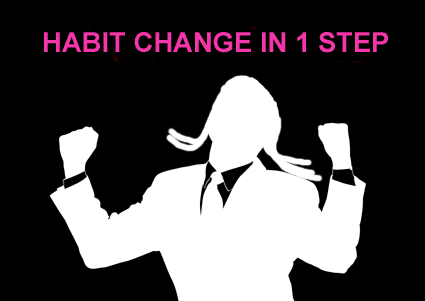 Habit change is alive and well. It happens every day, whether we are aware or not. The techniques we used to change habits years ago (I’m talking ten or a hundred or a thousand) are the same ones we use today. How this is possible is that the basic core of our psychology has not changed. We, humans, are who we are, and we react the way we react until we mold ourselves int humanitarians. New techniques are packaged differently, but they end up drawing from a small pool of possibilities that remain the same.
Habit change is alive and well. It happens every day, whether we are aware or not. The techniques we used to change habits years ago (I’m talking ten or a hundred or a thousand) are the same ones we use today. How this is possible is that the basic core of our psychology has not changed. We, humans, are who we are, and we react the way we react until we mold ourselves int humanitarians. New techniques are packaged differently, but they end up drawing from a small pool of possibilities that remain the same.
THE HABIT
The habit is a behavior pattern acquired by frequent repetition. We do it almost automatically. We have done it so many times that it no longer requires step by step thought.
As we know, there are several kinds of habits: 1) personal, 2) social (I am adding this one as of 2017, rather than combining it with the first) and 3) universal. They intertwine, but one affects our own body, another affects our self-perception and others. The other affects the outcome of the world.
1) Walking and exercise are personal habits. Once we have mastered them, we just do them! We no longer falter or wobble. We have trained our mind to focus on the activity and our environment; we have trained our muscles to perform the tasks.
2) On the other hand, there are flirtations with others we have developed to produce companionship or personas we embody to seem as if we are wealthy in the presence of the wealthy. For both of these, there is a fine line between habit and individual behavior. Sometimes, though, we act one way so often that it becomes “the” way we act. And, in this case, it is a habit.
3) Then we have prejudice or our habit of automatically going to war to fix conflict. These are universal habits. Once we know them, they are ours to own. We have trained our minds to embrace these habits. Every occurrence strengthens the habit. No matter how we came upon it, whether we were raised that way, hurt by someone of a particular group and turned our discomfort to the whole group, or told not to be a wuss so we lashed out; we have developed it.
HABIT CHANGE – THE GOOD NEWS
The good news is that habit change exists in ONE STEP. Have methods changed? Not really. Why? Because we still develop a habit the same way as one thousand years ago. The habit might be chronologically telling, but habits become ours through reacting to a trigger whose behavior gets us a reward, and repeating the reaction when triggered.
The simplest technique, and the one I always advocate, is based on the shortest road to success. The One Step Method (just beginning with the first step) is here for habit change. It’s always been there. Many have used it for many years without announcing they are using some technique to change a habit. Most have just responded to their trigger (a trigger such as an urge for something sweet, an urge to call someone an ethnic name, an urge to our protective of our country) by doing a new behavior over and over again. The result was that the urge for the sweet turned into an action to go eat a salad instead of going to eat ice cream, the urge to name call turned into self-reflection, the urge to protect the country turned into creating a framework to cause harmony rather than war.
CONCLUSION AND ACTION STEPS
Habit change in one step requires courage. We have to create a plan of action, immediately. Here are three behaviors as examples of what we might want to change with an action for each.
1) PERSONAL HABIT. If we want to combat eating ice cream when we crave sweets, our step would be to prepare salad with a few raisins, grapes, strawberries in it (this is an example) so that it is ready for eating upon our next urge. The same holds true if we desire a drink or a drug. We need to prepare a behavior beforehand, such as running around the block and saying hello to one neighbor. This running action will change perspective. It will give us a moment to see things other than our own existence, since we will be out in the world. Eating the salad may also be a solution to change the urge to drink or drug.
2) SOCIAL HABIT. If we get the urge to fit in and act something other than we are, our step would be to prepare a one-line greeting that does not reflect someone we are not and reflects who we are. Instead of saying how much fun we just had at OUR country club (if this is untrue), we might say, and this takes guts,
“I spent a lot of time in self-reflection.”
And working on habit change is, in fact, self-reflection. This rehearsed statement would also be a way to remind ourselves we are working on ourselves. And once we repeat the new behavior enough, our trigger of being false to impress will change into something new, possibly one that urges us to relay who we really are.
3) UNIVERSAL HABIT. If we want to combat our urge to slur someone of a particular ethnicity, we can create a sentence we will immediately text to a friend,
“I want to make an ethnic slur. Can we talk about this?”
This act will satisfy the urge to take action upon seeing the particular ethnic person. It will not hurt anyone, and it will allow us to discuss this anti-social urge with a friend. Eventually, this self-exploration will cause our urge to change
___
Planning is the key action step. We have to be ready for our own selves because we have loads of habits, and all behaviors are triggered by the need for some reward. Let us prepare to elevate ourselves. Habits do not have to rule us. If we take a moment to temper ourselves, we realize we are in charge of habits and habit change.
DIANE GOLD, PUBLISHER AND AUTHOR
Diane Gold, Founder of Warriors of Weight, Turning Habits Into Health, has been a mentor in tai chi, kung fu and meditation, has been a music, fitness and stress expert, dedicated mom, studying peaceful conflict resolution, habit replacement and has been certified in plant-based nutrition.
She believes in habit change. She says,
“When we have a method, we make great strides. When we randomly proceed to succeed, we are missing the very step that is required to create or re-create a habit: repetition. Using the one-step method is the simplest way to go. It allows for one pointed focus. No matter what.
“Think about it. Take one step. One step might not be simple, but it is less scary than two steps. And it is a success story in itself.
“Let’s consider that we can habit change. We choose when.
“By being aware of this, we can be kind of protective of ourselves and our fellow beings at all costs – and we are all always worth it.”

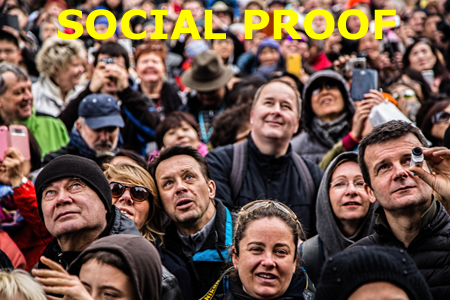 Social proof is the sociological/psychological phenomenon of where people “reference the behavior of others to guide their own behavior.” [Jennifer Cardello- Nielson-Norman Group] Another way of saying it is being influenced by other people’s choices (O.P.C.) to the point of making the same one.
Social proof is the sociological/psychological phenomenon of where people “reference the behavior of others to guide their own behavior.” [Jennifer Cardello- Nielson-Norman Group] Another way of saying it is being influenced by other people’s choices (O.P.C.) to the point of making the same one.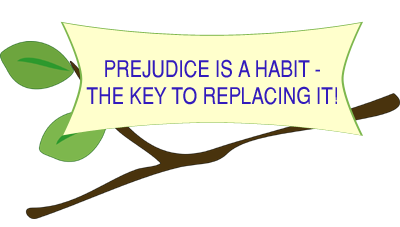 Prejudice is a habit, if we agree that a habit is a routine caused by repetition or an acquired pattern of behavior. As with all habits, they can become dormant when replaced by a new one. Some take a moment, others takes what seems like a lifetime. Our habits, for better or worse, are always with us; but we can shuffle them to the background.
Prejudice is a habit, if we agree that a habit is a routine caused by repetition or an acquired pattern of behavior. As with all habits, they can become dormant when replaced by a new one. Some take a moment, others takes what seems like a lifetime. Our habits, for better or worse, are always with us; but we can shuffle them to the background.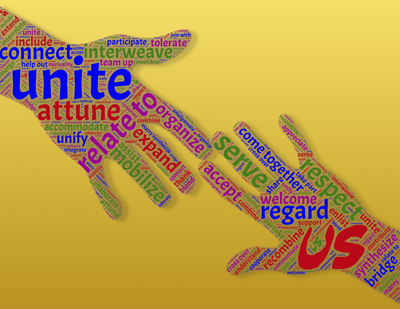 Prejudice is a habit, and as with any other habit, can be laid to dormancy like so many of our habits. It can happen if we choose to talk and express how we feel. It doesn’t always work right away; it usually makes changes. So, let’s become members of the Prejudice Replacement Club and get peace done.
Prejudice is a habit, and as with any other habit, can be laid to dormancy like so many of our habits. It can happen if we choose to talk and express how we feel. It doesn’t always work right away; it usually makes changes. So, let’s become members of the Prejudice Replacement Club and get peace done. Getting rid of nausea is a wonderful thing. When nausea consumes us, we forget about all the time we have spent in our lives without it. But, it’s always heavenly if we can figure out a way like to get rid of it, even temporarily.
Getting rid of nausea is a wonderful thing. When nausea consumes us, we forget about all the time we have spent in our lives without it. But, it’s always heavenly if we can figure out a way like to get rid of it, even temporarily.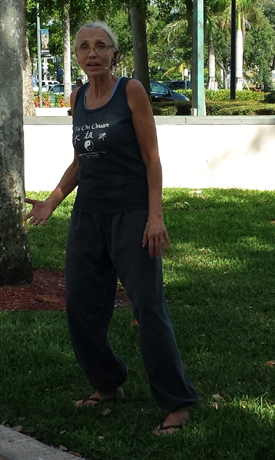
 I had 60 “perfect health” years. Now I’m having some imperfect health. Not so bad on the scale of things. Super, in fact; and I look forward to perfect health, even if it’s not all the time. I am forever grateful for all the gifts I have, and I am thrilled at imperfect health fixing using the one step technique that I always profess, that it is here for me now and it works well.
I had 60 “perfect health” years. Now I’m having some imperfect health. Not so bad on the scale of things. Super, in fact; and I look forward to perfect health, even if it’s not all the time. I am forever grateful for all the gifts I have, and I am thrilled at imperfect health fixing using the one step technique that I always profess, that it is here for me now and it works well.

 Conflict resolution education deals with how to handle a serious difference. We might call it an argument or a fight when people are using defensive language about their position. Depending upon how people were trained/schooled to proceed, this can lead to violence, which proper education can minimize.
Conflict resolution education deals with how to handle a serious difference. We might call it an argument or a fight when people are using defensive language about their position. Depending upon how people were trained/schooled to proceed, this can lead to violence, which proper education can minimize.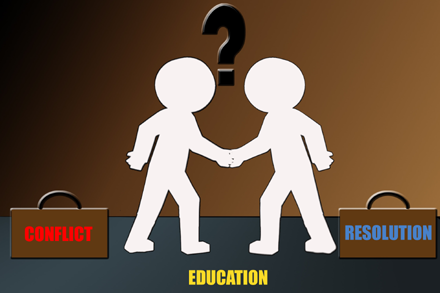
 GMO labeling (genetically modified organism labeling) is in Vermont. There are exemptions for dairy. But the Vermont law is a tremendous feat, considering Vermont was sued by Big Food and won.
GMO labeling (genetically modified organism labeling) is in Vermont. There are exemptions for dairy. But the Vermont law is a tremendous feat, considering Vermont was sued by Big Food and won.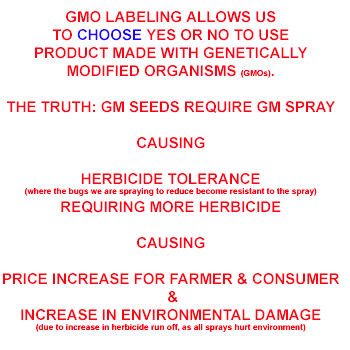
 So, back to the produce aisle. I go to the organic fruit or veggies. When I see something I wish to eat, I need to find out what kind of wax coating is on it. The FDA (Food and Drug Administration) has a very biased and inferior regulation about how wax coating has to be labeled. It is not adequate or useful for me. Here, in Title 21 of the Code of Food Regulations 101.4, it says,
So, back to the produce aisle. I go to the organic fruit or veggies. When I see something I wish to eat, I need to find out what kind of wax coating is on it. The FDA (Food and Drug Administration) has a very biased and inferior regulation about how wax coating has to be labeled. It is not adequate or useful for me. Here, in Title 21 of the Code of Food Regulations 101.4, it says, Please hear me and arrange to carry a source list of wax. You are large and powerful, so your farms and finishers will want your business and will do what you ask. I would help you if you asked. What if I am allergic to lac beetle and don’t see the sign that says the word “shellac,” made from lac beetle because it is on the box in the back, out of sight?
Please hear me and arrange to carry a source list of wax. You are large and powerful, so your farms and finishers will want your business and will do what you ask. I would help you if you asked. What if I am allergic to lac beetle and don’t see the sign that says the word “shellac,” made from lac beetle because it is on the box in the back, out of sight?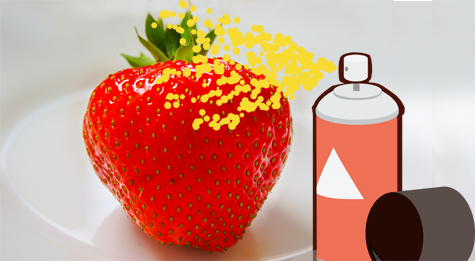 Whether we are parents, teachers, concerned friends; we have to be knowledgeable about what’s on your produce, that is, our produce. In order to be knowledgeable, we have to have knowledge.
Whether we are parents, teachers, concerned friends; we have to be knowledgeable about what’s on your produce, that is, our produce. In order to be knowledgeable, we have to have knowledge. Are we lab rats for which assessment must be made that if pesticides on a food rise beyond our tolerance level, we will die? Or should we protect ourselves should we protect our waterways which means, ultimately, our drinking water?
Are we lab rats for which assessment must be made that if pesticides on a food rise beyond our tolerance level, we will die? Or should we protect ourselves should we protect our waterways which means, ultimately, our drinking water? The greatest stress relief technique is here. It is almost nothing. It can be done anywhere by anyone at any time. There are a few simple steps to get there, but not much has to be done.
The greatest stress relief technique is here. It is almost nothing. It can be done anywhere by anyone at any time. There are a few simple steps to get there, but not much has to be done.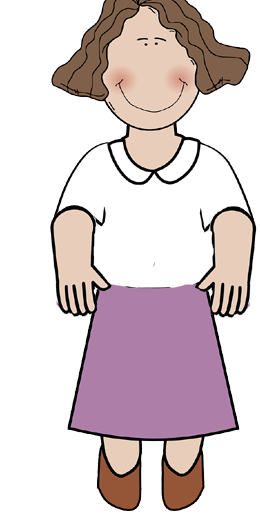 Yes, the great stress relief technique is the most simple way for us to gather our focus together. The events of our day may lead us to scatter, stress and naturally prompt our minds to develop pinball action.
Yes, the great stress relief technique is the most simple way for us to gather our focus together. The events of our day may lead us to scatter, stress and naturally prompt our minds to develop pinball action.





